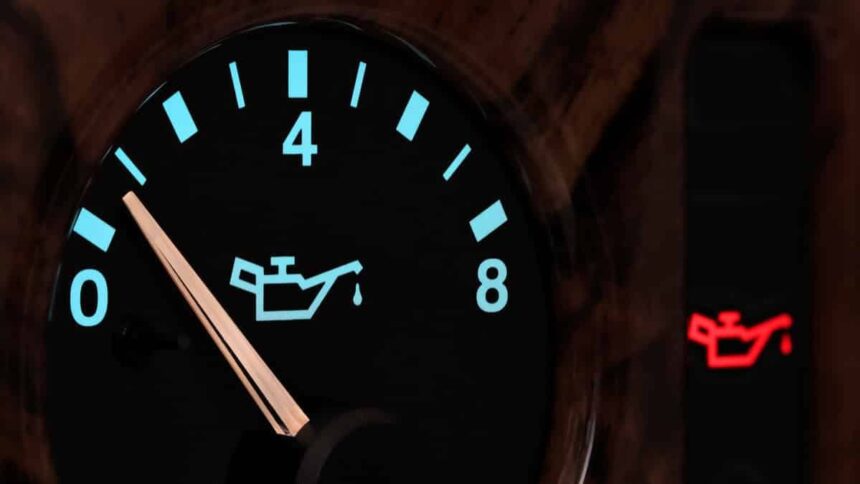If you’re noticing low oil pressure at idle, it’s important to address it quickly. Low oil pressure at idle means that your engine isn’t getting the proper amount of oil when it’s running slowly. This can lead to big problems if not fixed soon. Oil keeps your engine’s parts moving smoothly and helps prevent damage.
There are several reasons why you might see low oil pressure at idle. It could be due to old or dirty oil, low oil levels, or a faulty oil pump. Knowing the signs and what causes them can help you keep your engine in good shape. Keep reading to find out how to fix low oil pressure at idle and what might be going wrong with your vehicle.
What Is Low Oil Pressure at Idle?
Low oil pressure at idle means your engine isn’t getting enough oil when it’s running slowly. This is a problem because oil helps the engine’s parts move smoothly. Without enough oil pressure, these parts might get damaged over time.
When your car is idling, the oil pressure should be steady. If the gauge or light shows low pressure, it’s a sign something might be wrong. This could mean the oil isn’t flowing properly or the oil pump isn’t working right.
To keep your engine running well, it’s important to keep an eye on the oil pressure. Regular checks and maintenance can help prevent issues before they become serious problems.
Signs of Low Oil Pressure at Idle
If you notice a warning light or gauge reading low oil pressure at idle, it’s important to act quickly. One common sign is a warning light on the dashboard. This light tells you that the oil pressure is lower than it should be.
Another sign is if the oil pressure gauge shows a low reading while the engine is idling. This can mean the oil isn’t flowing well or there’s a problem with the oil system. Both signs mean you should check the oil and possibly visit a mechanic.
Listening to your car’s signals is crucial. If you see these signs, don’t ignore them. Act fast to check the oil and get your car serviced if needed.
Common Causes of Low Oil Pressure at Idle
Several things can cause low oil pressure at idle. One common cause is dirty or old oil. As oil gets dirty, it doesn’t lubricate the engine well, which can lower the oil pressure.
Another cause could be a low oil level. If there’s not enough oil in the engine, it can’t maintain proper pressure. Additionally, a faulty oil pump might not push oil through the engine correctly, leading to low oil pressure.
Checking and changing your oil regularly can help prevent these problems. Keeping your engine well-maintained is key to avoiding low oil pressure issues.
How to Check for Low Oil Pressure at Idle

To check for low oil pressure at idle, first, look at the oil pressure gauge or warning light on your dashboard. If the gauge shows low pressure or the light is on, it means there’s a problem.
Next, check the oil level using the dipstick. If the oil level is low, add more oil to see if it fixes the problem. If the oil level is fine, but the pressure is still low, it might be time to visit a mechanic.
Regularly checking your oil pressure can help catch problems early. This simple check can save you from bigger engine issues later.
Why Is My Car Showing Low Oil Pressure at Idle?
If your car shows low oil pressure at idle, there could be several reasons. It might be due to old or dirty oil that needs changing. Dirty oil doesn’t flow well and can lower oil pressure.
Another reason could be a problem with the oil pump. If the pump isn’t working properly, it can’t push oil through the engine effectively. Low oil levels can also cause this issue, so it’s important to keep your oil at the right level.
Understanding why this happens helps you address the issue quickly. Regular maintenance and timely oil changes are essential for avoiding low oil pressure problems.
Fixing Low Oil Pressure at Idle: Step-by-Step Guide
To fix low oil pressure at idle, start by checking your oil level. Use the dipstick to see if the oil level is low. If it is, add the right type of oil for your car.
Next, check the oil quality. If the oil looks dirty or old, change it. Also, inspect the oil filter. A clogged filter can affect oil flow, so replacing it might solve the problem.
If these steps don’t fix the issue, there might be a problem with the oil pump or other engine parts. In this case, it’s best to visit a mechanic for further inspection and repair.
How Dirty Oil Causes Low Oil Pressure at Idle
Dirty oil can cause low oil pressure at idle because it doesn’t flow properly. Over time, oil picks up dirt and debris, which makes it less effective at lubricating the engine. This can lower the oil pressure.
When the oil is dirty, it also loses its ability to cool the engine. This can lead to overheating and more engine problems. Regular oil changes help keep the oil clean and maintain proper oil pressure.
Changing your oil on schedule prevents dirty oil from causing low pressure issues. It’s a simple way to keep your engine running smoothly and avoid potential damage.
The Impact of Low Oil Levels on Oil Pressure at Idle
Low oil levels can have a big impact on oil pressure at idle. When there isn’t enough oil in the engine, the oil pump can’t circulate oil properly. This often leads to a drop in oil pressure.
Low oil levels can also cause engine parts to wear out faster. Without enough oil, these parts don’t get the lubrication they need. This can result in serious engine damage over time.
To avoid these issues, regularly check and maintain your oil level. Keeping your oil at the right level helps ensure proper oil pressure and engine health.
Oil Pump Issues and Low Oil Pressure at Idle
An oil pump issue can cause low oil pressure at idle. The oil pump is responsible for moving oil through the engine. If the pump isn’t working correctly, it can’t provide enough oil pressure.
Common oil pump problems include wear and tear or a malfunctioning pump. These issues can lead to lower oil pressure and engine damage. If you suspect an oil pump issue, it’s important to get it checked by a mechanic.
Fixing oil pump problems quickly can prevent further engine damage. Regular maintenance can also help keep the oil pump in good working condition.
Does the Wrong Oil Type Affect Low Oil Pressure at Idle?
Using the wrong oil type can affect low oil pressure at idle. Each engine needs a specific oil grade to run properly. If the oil is too thick or too thin, it can impact oil pressure.
Oil that is too thick won’t flow well, especially at low speeds. Conversely, oil that is too thin might not provide enough lubrication. Both situations can lead to low oil pressure issues.
Always use the oil type recommended by your vehicle’s manufacturer. This ensures proper oil flow and pressure, keeping your engine running smoothly.
How to Change Your Oil to Prevent Low Oil Pressure at Idle
Changing your oil regularly helps prevent low oil pressure at idle. Start by draining the old oil from your engine. Make sure to use the correct type and amount of new oil.
Replace the oil filter during an oil change. A new filter ensures that the oil flows properly through the engine. Following your vehicle’s maintenance schedule helps keep oil pressure at the right level.
Regular oil changes are key to maintaining good oil pressure. They also help keep your engine in top condition and prevent problems like low oil pressure.
Understanding Oil Pressure Gauges and Low Oil Pressure at Idle
Oil pressure gauges show you the level of oil pressure in your engine. A low reading on the gauge might indicate that the oil pressure is too low at idle. This can be a sign of several issues.
The gauge might also show low oil pressure if there is a problem with the oil pump or oil level. Understanding how to read the gauge helps you diagnose potential problems early.
Regularly monitoring the oil pressure gauge helps you catch issues before they become serious. Keeping an eye on this gauge is an important part of vehicle maintenance.
When to Visit a Mechanic for Low Oil Pressure at Idle
If you notice low oil pressure at idle, it’s important to know when to visit a mechanic. If you’ve checked the oil level and quality, but the problem persists, a mechanic should inspect your vehicle.
A mechanic can diagnose issues like a faulty oil pump or clogged oil filter. They can also check for engine damage caused by low oil pressure. Getting professional help can prevent further damage.
Regular visits to a mechanic for oil changes and maintenance can help avoid low oil pressure problems. Timely inspections keep your engine in good shape.
Why Regular Oil Changes Prevent Low Oil Pressure at Idle
Regular oil changes are crucial for preventing low oil pressure at idle. Over time, oil breaks down and becomes dirty, which can lower oil pressure. Changing the oil helps maintain proper pressure.
New oil also helps keep engine parts lubricated and cool. This prevents damage and keeps the engine running smoothly. Following the manufacturer’s oil change schedule is important for engine health.
Keeping up with regular oil changes helps avoid low oil pressure issues and extends the life of your engine. It’s an easy way to keep your vehicle in good condition.
How to Detect Low Oil Pressure at Idle Early
Detecting low oil pressure at idle early can save you from bigger problems. Start by regularly checking your oil pressure gauge or warning light. If you notice a drop in pressure, it’s a sign that something might be wrong.
You should also listen for unusual noises from the engine, like knocking or ticking sounds. These noises can indicate low oil pressure or other issues. Addressing these signs early helps prevent engine damage.
Regular maintenance and monitoring can help you catch low oil pressure problems before they become serious. Early detection is key to keeping your engine healthy.
The Role of the Oil Filter in Low Oil Pressure at Idle
The oil filter plays a big role in maintaining oil pressure at idle. A clogged or dirty oil filter can restrict oil flow, leading to low oil pressure. Replacing the oil filter regularly helps ensure proper oil flow.
A good quality oil filter traps dirt and debris, preventing them from reaching the engine. This helps maintain oil pressure and keeps the engine running smoothly. Changing the filter during oil changes is important.
Keeping your oil filter in good condition helps prevent low oil pressure issues. It’s a simple but important part of engine maintenance.
Engine Damage from Prolonged Low Oil Pressure at Idle
Prolonged low oil pressure at idle can cause serious engine damage. Without enough oil pressure, the engine parts don’t get the lubrication they need. This can lead to overheating, wear, and even engine failure.
Engine damage from low oil pressure can be costly to repair. It’s important to address low oil pressure issues as soon as they arise to prevent long-term damage.
Regular maintenance and timely repairs can help avoid engine damage. Keeping an eye on oil pressure and addressing problems early is key to preserving your engine’s health.
What to Do if You See Low Oil Pressure at Idle
If you see low oil pressure at idle, there are a few steps to take. First, check the oil level and quality using the dipstick. If the oil is low or dirty, add new oil or change it.
Next, inspect the oil filter. If it’s clogged or old, replace it. If the problem persists, there might be a more serious issue with the oil pump or engine. In this case, visit a mechanic for further inspection.
Taking these steps can help resolve low oil pressure issues and keep your engine running smoothly. Regular maintenance is key to preventing problems.
Preventative Maintenance to Avoid Low Oil Pressure at Idle

Preventative maintenance is important for avoiding low oil pressure at idle. Regularly check and change your oil to keep it clean and effective. Also, replace the oil filter as part of your routine maintenance.
Keeping an eye on your oil pressure gauge and warning lights helps catch problems early. Address any issues promptly to prevent more serious damage.
By following a regular maintenance schedule, you can keep your oil pressure at the right level and avoid engine problems. This helps ensure your vehicle runs smoothly and reliably.
Top Tips for Managing Low Oil Pressure at Idle
Managing low oil pressure at idle involves a few key tips. First, regularly check your oil level and quality. Add oil or change it as needed to keep the pressure within the normal range.
Next, ensure your oil filter is clean and functioning properly. A clogged filter can affect oil pressure, so replace it as part of your maintenance routine. Also, use the right oil type for your engine to ensure proper flow and lubrication.
Following these tips helps maintain proper oil pressure and keep your engine in good condition. Regular maintenance is essential for avoiding low oil pressure problems.
Conclusion
Low oil pressure at idle is something you shouldn’t ignore. When your car’s oil pressure is too low, it means the engine isn’t getting the oil it needs to stay healthy. This can lead to bigger problems like engine damage if not fixed quickly. Keeping an eye on your oil level and oil quality is a simple way to prevent issues.
Regular oil changes and maintenance are key to avoiding low oil pressure. By checking your oil and keeping your engine in good shape, you help ensure a smooth and reliable ride. If you ever see low oil pressure on your dashboard, it’s important to act fast and get your car checked out. This helps keep your engine running well for a long time.







